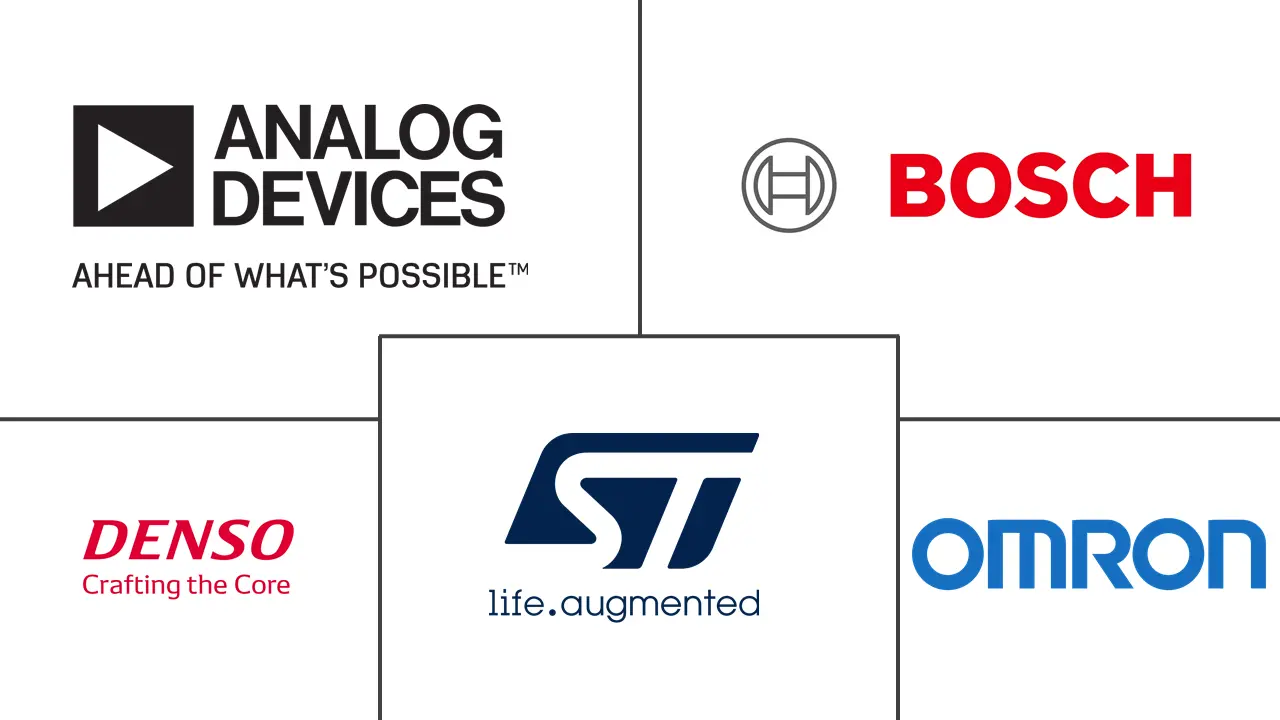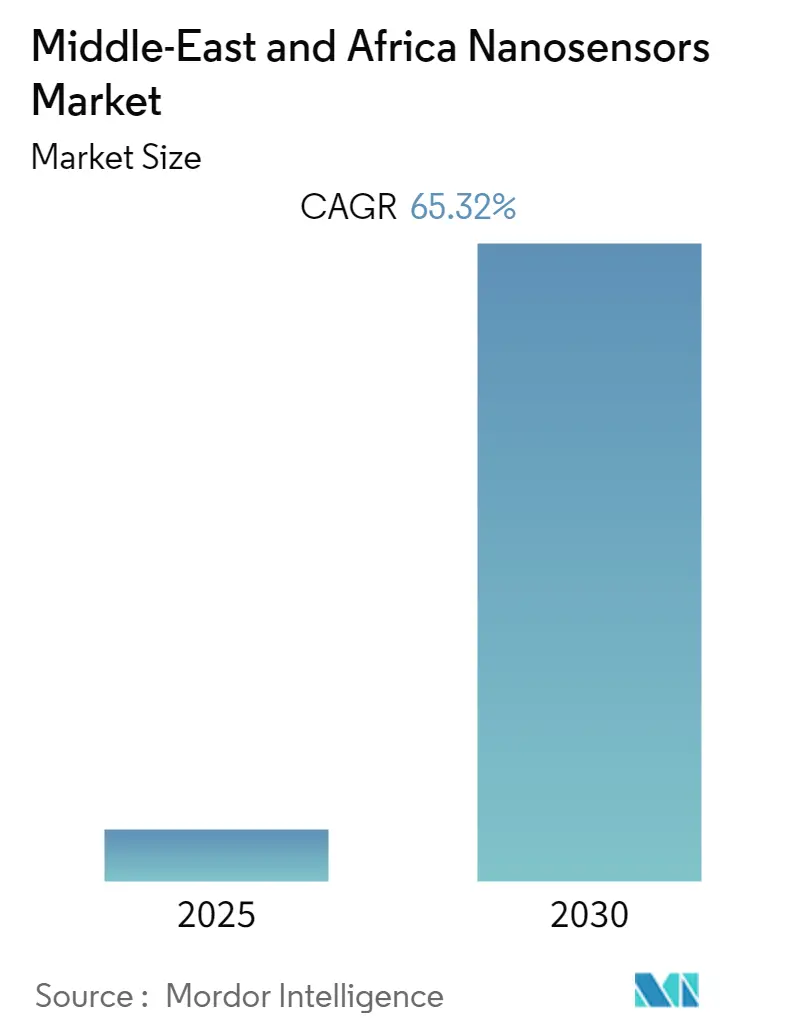
Middle-East and Africa Nanosensors Market Analysis by Mordor Intelligence
The Middle-East and Africa Nanosensors Market is expected to register a CAGR of 65.32% during the forecast period.
- Nanosensors are among the notable inventions in the field of nanotechnology. The sensors are manufactured on the nanoscale and are designed to collect information on the nanoscale. Since their invention, nanosensors have made inroads into several industries. There are several industries where these sensors can contribute to offer disruption and economic and environmental impacts in the Middle East.
- The major trends driving the Middle-East and Africa nanosensors market in the automotive sector are miniaturizations and improved communication capabilities, enabling their integration into vehicles without interfering with the basic functionalities of the vehicle, while the factor driving the growth of the nanosensors market in Africa is its growing use in various applications, such as automotive and medical.
- According to Dubizzle, an online buy marketplace to buy and sell products in the UAE, about six in 10 UAE consumers are considering whether to buy a car in the next six months. As the Middle Eastern automotive sector is a key market for high-performance cars, such trends are expected to drive the demand for nanosensors.
- Furthermore, advancements in nanotechnology have revolutionized many aspects of the oil and gas industry. According to OPEC, Saudi Arabia possesses around 17% of the world's proven petroleum reserves. The oil and gas sector accounts for about 50% of gross domestic product and about 70% of export earnings.
- Nanosensors are used in the oil and gas sector for temperature and pressure measurement. Furthermore, pollution by chemicals or gases is also a difficult aspect of petroleum production. The vast sea of applications of nanosensors is being explored for effective utilization in the oil and gas sector, especially in improving the recovery efficiency of the oilfield.
- The global outbreak of COVID-19 had a significant impact on the Middle-Eastern region. The pandemic primarily impacted the automotive and oil and gas sector of the countries in this region, which is the backbone of the economies in this region. According to OECD, more than 2.2 million COVID-19 infections have been registered in the MENA region. Among Arab economies, Iraq has the most confirmed cases, followed by Saudi Arabia and Morocco.
- However, the governments in the region had made important efforts to address the COVID-19 health crisis early on, which helped them contain the spread of the virus. With the condition moving toward normalcy, the MEA region is anticipated to create a favorable environment for the growth of the nanosensors market during the forecast period.
Middle-East and Africa Nanosensors Market Trends and Insights
Healthcare to Hold a Significant Market Share
- The Middle-Eastern region is seeing a boom in the healthcare sector, owing to the economic growth of the countries in the region. In most countries, efficient and effective utilization of healthcare resources is the key strategy for improving health outcomes.
- For instance, according to the World Bank, healthcare expenditures in the UAE reached USD 18.2 billion in 2018 and were expected to rise to USD 21.3 billion by 2021. Overall, healthcare spending was projected to account for 4.6% of the country's GDP by 2026, up from 4.27% in 2018.
- Demographic shifts, changing lifestyles, and population growth are among the key drivers for the growth of the healthcare sector in the country. According to the World Bank, the UAE's population would grow from 9.4 million people in 2017 to 11.055 million by 2030.
- Nanotechnology stands to produce significant scientific and technological advances in diverse fields, including healthcare and pharma. Furthermore, acceleration in developing technologies and intelligence healthcare systems is moving toward novel approaches and models of healthcare based on nanosensors, smartphones, smartwatches, etc.
- The ability of nanosensors to detect important molecules, such as disease-related metabolites, proteins, nucleic acids, pathogens, and cells, is expected to drive the demand from the healthcare sector of the MEA region.
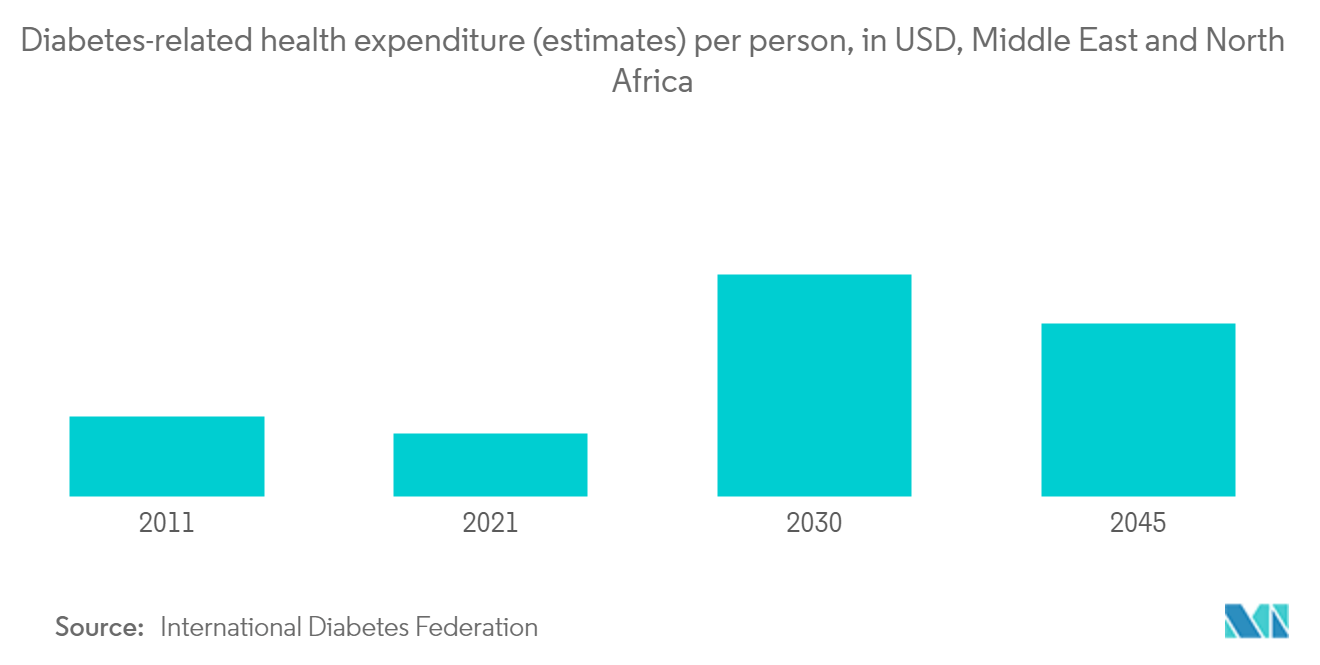
Saudi Arabia to Hold a Significant Market Share
- Saudi Arabia is the largest country in the Middle-Eastern region, with a population of over 35 million. Furthermore, according to ITA, Saudi Arabia has the second-largest proven oil reserves in the world (about 266 billion barrels).
- The applications of nanosensors in the oil and gas industry are increasing, as global energy consumption is constantly increasing every year. The industry needs technological innovations to meet this immediate demand.
- The nanosensors can perform several functions, such as they can be injected into a reservoir with fluid and can help the operation teams obtain more information about the porosity, permeability, and temperature of the reservoir. Furthermore, nanosensors can also be used for temperature sensing, magnetic sensing, and optical imaging applications.
- Furthermore, Saudi Arabia is among the largest automotive market, which is expected to create opportunities for the growth of the nanosensors market in the region. According to ITA, Saudi Arabia accounted for almost 52% of the vehicles sold in the Gulf Cooperation Council (GCC) and 35% in the MENA region in 2020.
- In accordance with the Kingdom's vision 2030 goals, the National Industrial Development Center (NIDC) aims to attract 3-4 original equipment manufacturers across the ICE and EV value chain, with the goal of producing 300,000 vehicles annually, with a 40% local content by 2030.
- Similarly, the country's food and beverage, smart city infrastructure, and water and wastewater management sectors are also expected to drive the demand for nanosensors during the forecast period.
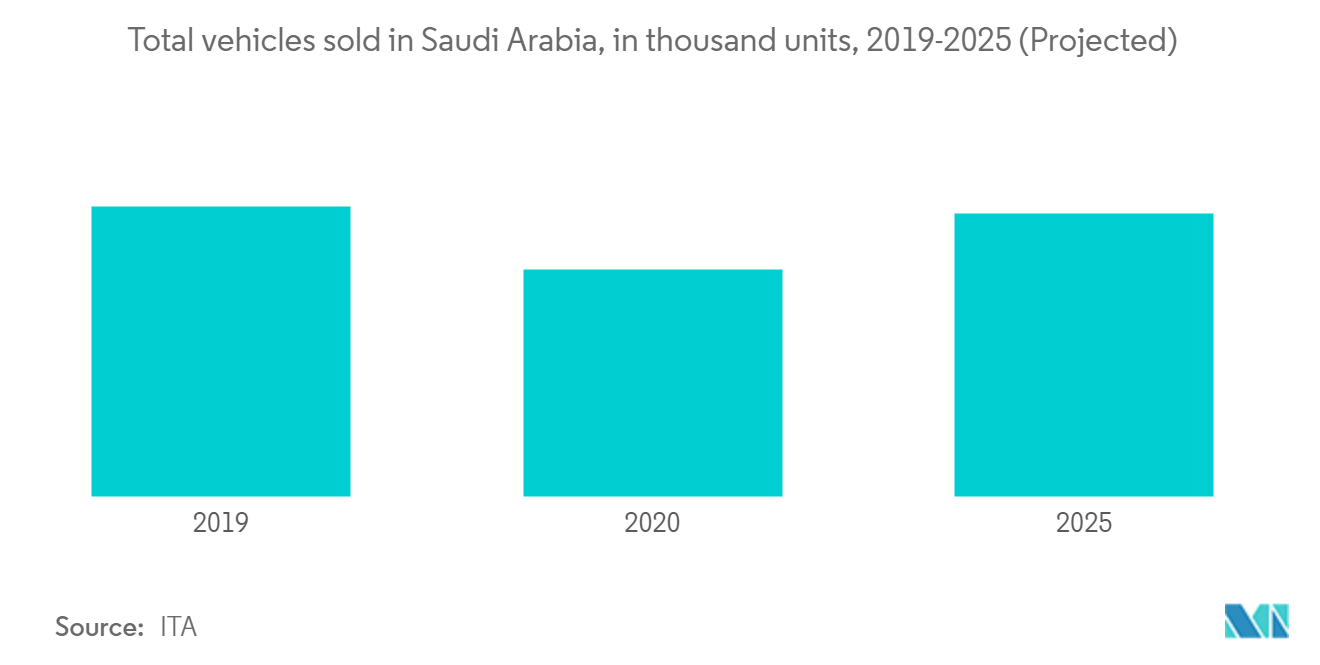
Competitive Landscape
The Middle-East and Africa nanosensors market is moderately competitive, with growing applications across various end-user verticals encouraging new players to enter the market. The key players operating in the market are focusing on achieving bulk manufacturing capability to keep the cost of the product low. Some of the major players operating in the market include Analog Devices Inc., Robert Bosch GmbH, Denso Corporation, and STMicroelectronics.
- September 2021 - The nano gas sensor manufacturer AeroNos unveiled a new development kit to help customers develop and integrate gas sensing capabilities into various product lines. The kit groups together multiple technologies required to build and test gas sensing applications for a variety of applications, such as fire safety, air quality, and environmental and greenhouse gas detection.
- July 2021 - A research team from the Technion-Israel Institute of Technology revealed that it produced and tested a tuberculosis-detecting skin patch that gives a diagnosis an hour after it is attached to the skin. The patch contains sensors made from nanoparticles.
Middle-East and Africa Nanosensors Industry Leaders
-
Analog Devices Inc.
-
Robert Bosch GmbH
-
Denso Corporation
-
Omron Corp.
-
STMicroelectronics
- *Disclaimer: Major Players sorted in no particular order
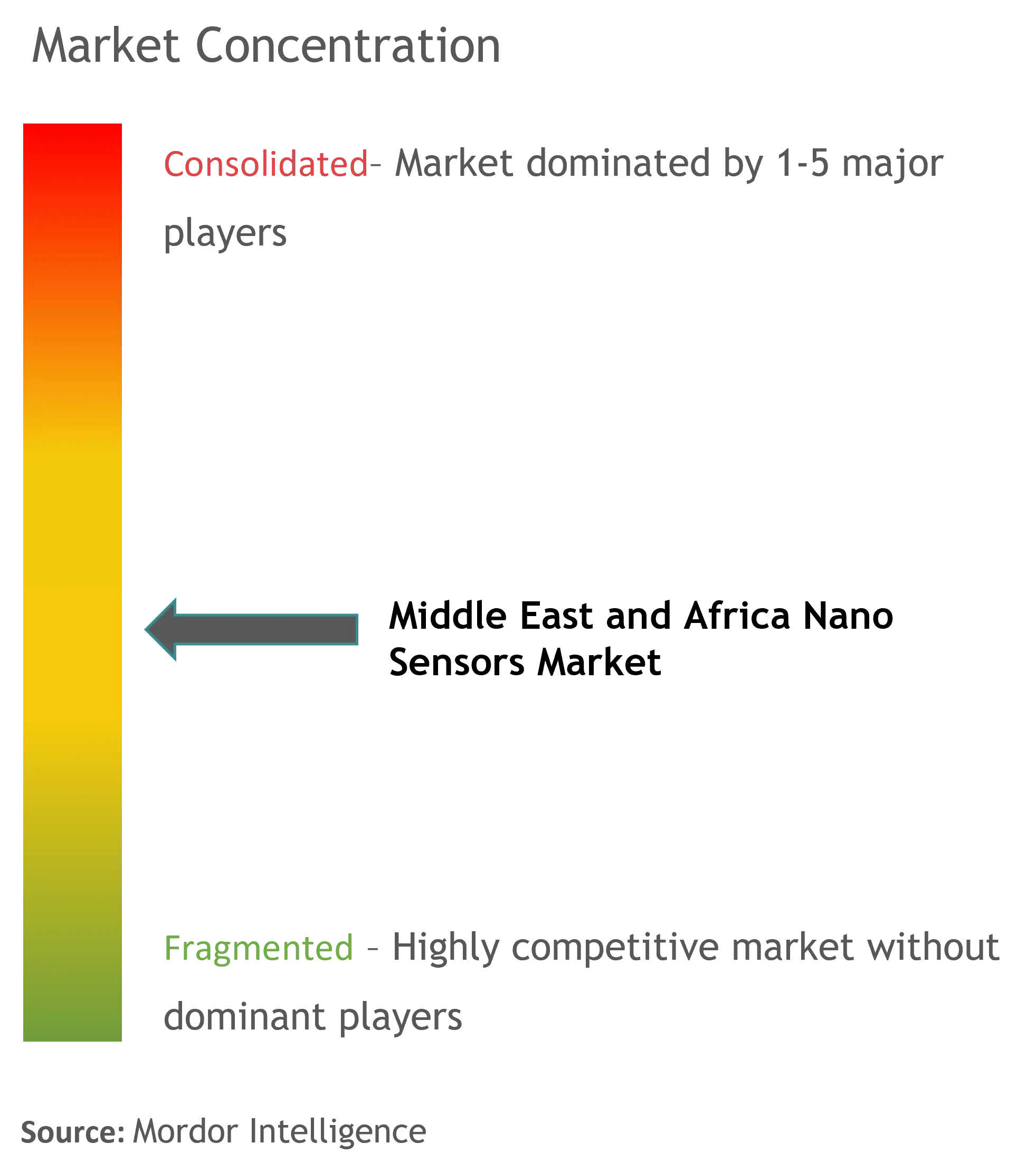
Recent Industry Developments
- May 2021 - MS-Tech, a global developer, manufacturer, and innovator of nanotechnology detection and diagnostics sensors, announced that its detection division completed shipments and installations of its EXPLOSCAN and DUOSCAN detectors across Europe, Africa, and the Middle East. DUOSCAN is a trace and vapor detection system that detects and identifies minute quantities of narcotics and explosives, as well as improvised explosives, such as TATP and HMTD.
- April 2021 - Panasonic Corporation announced that it had developed a manufacturable technology to drastically improve the device performance fabricated on silicon (Si) wafers by leveraging the unique feature of a photonic crystal structure, which can break the classical limitation of the heat insulation property of solids. Utilizing this technology, Panasonic will provide new thermography solutions with high-temperature resolutions and innovative thermal management solutions in microelectronic devices.
Middle-East and Africa Nanosensors Market Report Scope
Nanoparticles possess certain mechanical, chemical, and optical properties for use in biological sensors, nanoscale sensors, and other optical-electronic devices. Nanosensors primarily use such materials, which give them the capability to detect and convey data and information about the behavior and characteristics of objects at the nanoparticle level. The report offers a comprehensive analysis of the Middle-East and Africa nanosensors market.
| Force Sensor |
| Biosensors |
| Radiation Sensors |
| Chemical Sensors |
| Thermal Sensors |
| Consumer Electronics |
| Power Generation |
| Automotive |
| Petrochemical |
| Aerospace and Defense |
| Healthcare |
| Industrial |
| Other Industries |
| Saudi Arabia |
| United Arab Emirates |
| Israel |
| South Africa |
| Other Countries |
| By Type | Force Sensor |
| Biosensors | |
| Radiation Sensors | |
| Chemical Sensors | |
| Thermal Sensors | |
| By Industry | Consumer Electronics |
| Power Generation | |
| Automotive | |
| Petrochemical | |
| Aerospace and Defense | |
| Healthcare | |
| Industrial | |
| Other Industries | |
| By Country | Saudi Arabia |
| United Arab Emirates | |
| Israel | |
| South Africa | |
| Other Countries |
Key Questions Answered in the Report
What is the current Middle-East and Africa Nanosensors Market size?
The Middle-East and Africa Nanosensors Market is projected to register a CAGR of 65.32% during the forecast period (2025-2030)
Who are the key players in Middle-East and Africa Nanosensors Market?
Analog Devices Inc., Robert Bosch GmbH, Denso Corporation, Omron Corp. and STMicroelectronics are the major companies operating in the Middle-East and Africa Nanosensors Market.
What years does this Middle-East and Africa Nanosensors Market cover?
The report covers the Middle-East and Africa Nanosensors Market historical market size for years: 2019, 2020, 2021, 2022, 2023 and 2024. The report also forecasts the Middle-East and Africa Nanosensors Market size for years: 2025, 2026, 2027, 2028, 2029 and 2030.
Page last updated on:
Middle-East and Africa Nanosensors Market Report
Statistics for the 2025 Middle-East and Africa Nanosensors market share, size and revenue growth rate, created by Mordor Intelligence™ Industry Reports. Middle-East and Africa Nanosensors analysis includes a market forecast outlook for 2025 to 2030 and historical overview. Get a sample of this industry analysis as a free report PDF download.
